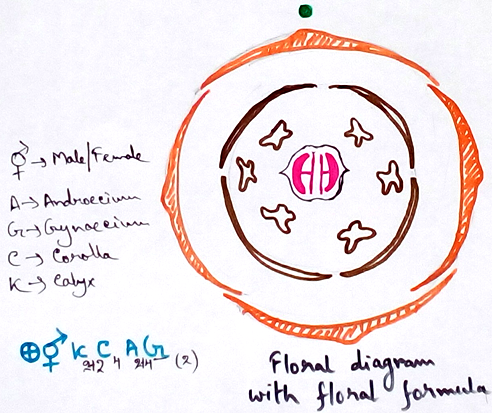Semi-technical Features of a Typical Flowering Plant
Family - Family of flowering plants can be divided into following – Asteraceae, Orchidiaceae, Solanacaea, Fabaceae, Rubiaceae, Poaceae, Lamiaceae, Euphorbiacea, Mealastomataceae etc.
Vegetative characters – This include
Leaf – Arrangement of leaves with reference to the stem is called phyllotaxy. It can be whorled (leaves are borne three or more in number at each node), opposite (leaves are formed in pairs) or alternate (single leaf is initiated at each node).
Root - Roots can be of mainly two types – primary root (it is the root which consists of main root and lateral branches of lateral root) and adventitious root ( roots that are arise from other than radical is called adventitious root. But in some special cases modification of roots are observed.
Stem - Stems are portions of shoot that bear branches, leaves, flower, fruits in their proper places. They are weak, hard, green or brown. Shrubs are having weak stem, stem of herbs are used as medicinal or flavouring agents, trees are having, brown woody hard stem. Stems of some plants are similar like leaves they are called cladophylls. Examples are Asparagus. Some stems can also formed bulb like structure such as corn.
Floral features – According to presence of number of whorls (calyx, corolla, flowers can be complete or incomplete.
Inflorescence -
According to Troll (in 1964 ) "the shoot system which serves for the formation
of flowers and which is modified accordingly" is called an inflorescence. They
are of different types -
Flower – According to shape flowers can be symmetrical ( can be cut into equal halves), asymmetric (cannot be cut into two equal halves). According to presence of male flower and female flowers it can be of two types – monoecious and dioecious.
Calyx – calyx are consists of sepals. They can be joined or bifurcated and epicalyxes may or may not be present.
Corolla – petals are associated together to form corolla. It can be of different shapes like bell, funnel, tube shape, wings shape etc.
Androecium – It consists of pollen tube and anther.
Gynoecium – gynoecium consists of ovary. According to position of ovary it can be of different types- superior ovary, inferior ovary.
Fruits - Fruits can be generally divided into simple (developed from a pistil of a single flower), aggregate (developed from single pistil of different flowers), multiple fruits (developed from an inflorescence axis and pistils of flower associated). Fleshy fruits can be divided into different types. They are drupes (endocarp is stony and tightly adherent to the seed, examples are peach, olive, plum), berry (endocarp of the fruit wall is fleshy and exocarp is skin like, examples are dates, grapes etc), pomes (endocarp is tough and membranous and edible part is not the part of food , examples are pear, apple).
Seeds - Endosperm of the seeds can be oily or non oily.
Floral formula – this includes different signs, symbols and number to express the type of flowers.
Floral diagram – It represent the origin, evolution, position of different parts of flower. From the floral diagram we are able to know about the entire structure of the plant in short.
From Semi-technical Features of a Typical Flowering Plant to HOME PAGE
Recent Articles
-
What Is Plasma? | Blood Plasma | Proteins | Nutrients | Cholesterol
Nov 07, 25 10:29 AM
Blood is a mobile fluid which is a connective tissue and is derived from the mesoderm like cell any other connective tissue. Colour of blood is reddish and that flows inside the blood vessels by means… -
Disorders of Respiratory System | Tuberculosis | Pleurisy | Emphysema
Oct 28, 25 11:39 PM
Tuberculosis is very common disease and is caused by a type of bacteria called Mycobacterium tuberculosis. This disease causes different trouble in the respiration and infection of several parts of th… -
Regulation of Respiration | Respiratory Centres | Inspiratory Area |
Oct 14, 25 12:13 AM
Respiratory Centre is the area that controls the rate of respiration and it is observed to be located in medulla oblongata and pons. Respiratory Centre has the following will dispersed components like… -
Explain Transport of Gases | External Respiration | Tissue Respiration
Oct 09, 25 11:35 PM
In humans gaseous exchange is completed in the following ways the steps are - External Respiration or Breathing - Breathing in false taking in of Oxygen and giving out of carbon dioxide in the body. M… -
Kind and Number of Teeth | Location of Teeth in Mouth | Care of Teeth
Sep 11, 25 12:52 AM
Kind and Number of Teeth






New! Comments
Have your say about what you just read! Leave me a comment in the box below.